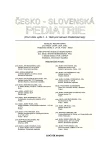The Role of Plasma Procalcitonin and Other Inflammatory Markers as Identifiers of Bacterial Infections in Children with Solid Tumor
Diagnostický význam prokalcitoninu a dalších markerů zánětu u dětí se solidními nádory
Autoři se zaměřili na diagnostický přínos prokalcitoninu (PCT), C-reaktivního proteinu (CRP) a sedimentace (FW) v predikci infekčních komplikací u dětí s febrilní neutropenií. Hodnotili také vliv absolutního počtu neutrofilů (ANC) a monocytů (AMC) na průběh infekce.
Sledované parametry měřili každý den u 21 pacientů (12 chlapců a 9 dívek) s febrilní neutropenií. První náběry provedli při tělesné teplotě > 38 °C před zahájením antibiotické léčby a posledních 24 hodin po vysazení antibiotik. Celková doba měření byla 5–17 dní (průměr 8,3 dne).
Věk pacientů byl 2 roky 6 měsíců – 24 let 6 měsíců (průměr 12 let 1 měsíc). Při hodnocení byly použity neparametrické statistické testy. Diagnózy pacientů: Ewingův sarkom 8krát, maligní mezenchymální nádor 7krát, osteosarkom 3krát, nádor CNS 2krát a non-Hodgkinský lymfom 1krát. Čtyři pacienti měli pozitivní hemokultury, šest pacientů mělo lokalizovanou infekci a u jedenácti pacientů se jednalo o teploty nejasné etiologie (FUO).
Patnáct pacientů mělo leukopenii IV. stupně – leu < 1,0 x 109/l a ANC<500. U šesti pacientů vznikly teploty při leu >1,0 x 109/l a ANC>500. U prokázané bakteriémie byl medián CRP D (den)1 -179,4 mg/l a D2 -143,9 mg/l, medián PCT D1 -0,41 ng/ml a D2 -0,47 ng/ml. U teplot nejasné etiologie byl medián CRP D1 -42,2 mg/l a D2 -78,15 mg/l a medián PCT D1 -0,345 ng/ml a D2 -0,635 ng/ml. Hodnota CRP měla nejlepší výpovědní hodnotu v rozlišení pozitivních hemokultur a FUO. Tento výsledek však nebyl statisticky významný. Mezi lokalizovanou infekcí a FUO nezaznamenali žádný rozdíl. Stanovení prokalcitoninu nerozlišilo pacienty s FUO, lokalizovanou infekcí ani s pozitivní hemokulturou (v souboru byli jen pacienti s grampozitivní bakteriémií). Počet dní s AMC<100 a ANC<500 koreloval s počtem dní s teplotou – u teplot, které ustoupily do tří dnů, byl 0,9 dne (0–4 dní) a 2,87 dní (2–4 dní), u teplot trvajících déle než tři dny 3,3 dní (0–8 dní) a 5,14 dne (1–9 dní).
Ve sdělení uvádí i souhrn literatury týkající se diagnostického výzkumu různých markerů zánětu u dětí s febrilní neutropenií.
Klíčová slova:
prokalcitonin, markery zánětu, febrilní neutropenie, děti, souhrn literatury
Authors:
J. Kruseová 1; M. Průcha 2
; M. Dostál 3; E. Pindurová 1; I. Lišková 1; O. Nyč 4; D. Sumerauer 1; J. Němcová 1; J. Starý 1
Authors‘ workplace:
Klinika dětské hematologie a onkologie 2. LF UK a FNM, Praha
přednosta prof. MUDr. J. Starý, DrSc.
1; Oddělení klinické biochemie, hematologie a imunologie, Nemocnice na Homolce, Praha
přednosta prof. MUDr. J. Hyánek, DrSc.
2; Ústav experimentální medicíny, Praha
přednostka prof. MUDr. E. Syková, DrSc.
3; Ústav klinické mikrobiologie 2. LF UK a FNM, Praha
přednosta MUDr. O. Nyč
4
Published in:
Čes-slov Pediat 2005; 60 (4): 206-212.
Category:
Original Papers
Overview
The authors evaluated the diagnostic impact of procalcitonin (PCT), C-reactive protein (CRP) blood sedimentation rate (FW), absolute neutrophil count (ANC) and absolute monocyte count (AMC) in the prediction of bacterial infection in children with febrile neutropenia.
They measured each indicator daily in 21 patients (12 boys and 9 girls) with febrile neutropenia. The first blood samples were taken when patient had fever > 38 °C before antibiotic treatment and the last sample 24 hour after antibiotic discontinuation. The period during which measurements were made ranged from five to 17 days (average 8.3 day).
#Patient age:
2 years and 6 months to 24 years and 6 months (average 12 years and 1 month). The authors used nonparametrical statistical methods.
#Patient diagnosis:
Ewing sarcoma 8 times, soft tissue sarcoma 7 times, osteosarcoma 3 times, CNS tumour twice and non-Hodgkin lymphoma once. Four patients had positive blood culture, six patients had local infection and eleven patients had fever of unknown origin (FUO).
Fifteen patients had leukopenia grade IV – leu<1.0x109/l and ANC<500 and six patients leu>1.0x109/l and ANC>500. Patient with bacteriemia had median CRP D (day)1 -179.4 mg/l and D2 -143.9 mg/l, median PCT D1 -0.41 ng/ml and D2 -0.47 ng/ml, patient with fever of unknown origin median CRP D1 -42.2 mg/l a D2 -78.15 mg/l and median PCT D1 -0.345 ng/ml a D2 -0.635 ng/ml. CRP had the best predictive role in distinguishing between positive blood culture and FUO. This results was not, however, statistically significant. There was no difference between FUO and local infection. Procalcitonin levels were no different among patients with FUO, local infection and positive blood culture (the group contained only patients with Gram positive bacteriemia). There was strong correlation between the number of days AMC<100 and ANC<500 and the number of days the patients had fever. Fevers resolved within 3 days the number of days with AMC<100 and ANC<500 lasted only 0.9 days (0–4 d) and 2.87 days (2–4 d), fevers lasted more than three days the number of days with AMC<100 and ANC<500 were 3.3 days (0–8 d) and 5.14 days (1–9 d).
This paper also contains a short summary of literature setting out the diagnostic impact of various infection markers in children with febrile neutropenia.
Key words:
procalcitonin, inflammation markers, febrile neutropenia, children, literature summary
Labels
Neonatology Paediatrics General practitioner for children and adolescentsArticle was published in
Czech-Slovak Pediatrics

2005 Issue 4
- What Effect Can Be Expected from Limosilactobacillus reuteri in Mucositis and Peri-Implantitis?
- The Importance of Limosilactobacillus reuteri in Administration to Diabetics with Gingivitis
Most read in this issue
- X-linked Hypophosphatemic Rickets
- The Role of Plasma Procalcitonin and Other Inflammatory Markers as Identifiers of Bacterial Infections in Children with Solid Tumor
- Importance of Molecular Genetic Examination for Diagnostics of Wilson Disease
- Intentional Poisoning with Lethal Dose of Imipramine in a 14-year Boy
